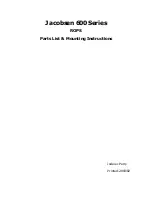
3
Magnet
Sensor
Chainwheel Spoke
Magnet
Chainwheel Spoke
Fig 3 Magnet &
Sensor Position
Fig 4 Magnet & Sensor Position
drilling the deck:
Drill a hole 13/32” (10.3mm) diameter through the deck. Ensure this hole is directly in line with the
sensor hole in the deckplate. The sensor wire must be fed through the deck. Before drilling into the deck, ensure there is
nothing below the deck that could be damaged. Also ensure any hole you drill will not weaken the boat’s structure.
ensure the
sensor head
is positioned so that it will not be hit by the chainwheel during windlass operation and that it is at
least 1ft (300mm) away from the battery and motor cables, then secure the sensor into the deckplate with silicone.
Sensor Wiring:
Refer to the wiring diagrams for instructions to connect the sensor wires to the AA550 console. Sensor
cable joins must be soldered and sealed in adhesive heat shrink tubing. Do not leave the cables hanging loose, they must be tied
in place with cable ties.
Magnet Installation for Vertical Windlasses Using Rope/Chain Rode
Some windlasses are supplied prefitted with magnets in the bottom of the chainwheel. This will work if you are using an
all-chain rode but, if you want an accurate count of your rope/chain rode you need to remove the prefitted magnet and fit a new
magnet in the top of the chainwheel so that the rode will run between the sensor and the magnet.
The 10mm x 8mm magnet (#9061) is used for most windlasses. Some smaller windlasses require the 8mm x 6mm
magnet (#9052) eg the Muir Atlantic 600. Check with your supplier or the AutoAnchor manufacturer if you are not sure
which magnet to use.
The magnet and sensor must be aligned so that the anchor rode passes between them. The centre of the magnet and the centre
of the sensor may be up to 10mm out of direct alignment. (See Fig 2 above). Templates and drilling instructions are supplied
for some windlasses. Note: The Lofrans Project 1000 and 1500 windlasses are predrilled for magnet installation in the bottom
of the chainwheel. Invert the chainwheel so that the magnet hole is in the top of the chainwheel.
If the windlass is not pre-drilled and you do not have a template, drill a hole for the magnet into the top of the chainwheel to
the depth required. Ensure the gap between the sensor and magnet will be correct as per the table above.
ensure the hole is
into a chainwheel spoke and that the magnet will be aligned over the sensor and the rode as it moves around the
chainwheel.
Refer Figs 1, 2 above and Figs 3, 4 below. Insert the magnet into the hole. (Magnet polarity is not relevant).
Cover the magnet with a minimum of 1mm of epoxy to seal it from salt water. Failure to do this will impair the magnet’s
durability.
FITTINg THe aa550 TO a VeRTICaL WINdLaSS WITH aN aLL-CHaIN ROde
The fit described above for rope/chain rode can also be used for all-chain rode, but it may be easier to fit the magnet in the
bottom of the chainwheel as set out below.
Sensor Installation for Vertical Windlasses Using all-Chain Rode
If the windlass is not factory drilled, or prefitted with a sensor, you will need to drill a hole 13/32” (10.3mm) diameter through
the windlass deckplate. The sensor position range (described above for rope/chain windlasses) is not relevant if the magnet is
fitted in the bottom of the chainwheel. The sensor hole can be drilled anywhere on the deckplate provided it is in alignment
with the magnet in the chainwheel.
Stern
Sensor Position Range
Bow
Chainwhee
l
90
o
Anchor Locker
Rode
Fig 1
gap Between the Sensor and Magnet:
The gap between the sensor and magnet is critical for proper operation of the
AA550. See below for the gap when the rode runs between the sensor and the magnet:
Magnet #9052 (8mm x6mm)
Minimum Gap 30mm
Maximum Gap 44mm
Magnet #9061 (10mm x 8mm)
Minimum Gap 35mm
Maximum Gap 50mm
Fig 2
Sensor & Magnet Alignment
10mm
Sensor
Magnet
Sensor
Magnet



























